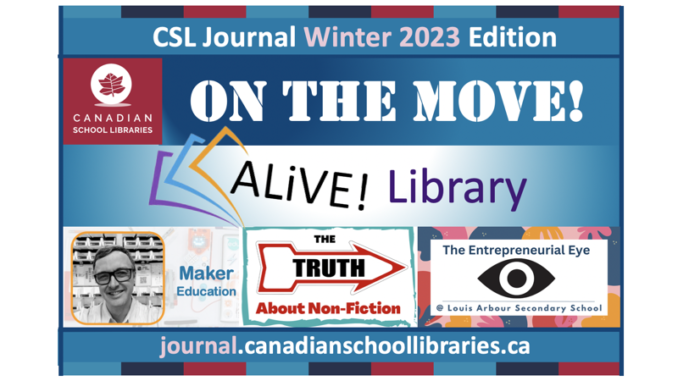
By Carol Koechlin and Anita Brooks Kirkland
As we prepared for the Winter 2023 edition of CSL Journal we once again were in awe of the talent and dedication of school library professionals right across Canada. We are admittedly still on a high from the outstanding participation in the TMC7 symposium, but more than that we admire the fresh vision and brave new initiatives that continue to come to our attention every time we prepare another journal issue.
As you explore this issue we hope you too are inspired by the work of our writers, and perhaps you will discover something you would like to delve further into.One ideal place to start is the article by Dr. David Loertscher on a website he has developed called ALiVE Library. Dr. Loerscher proclaims that, “Canada has led the world in the vision of the role the school library and learning commons can play in the education of successful and capable young learners.”
When you take the ALiVE Library tour, you will find five videos featuring interviews that Dr. Loertscher conducted with participants in CSL’s seventh Treasure Mountain Canada Symposium, held in October 2022 in New Westminster, BC. In this issue of CSL Journal, we feature TMC7 papers by Alanna King & Tim King, and by Beth Lyons, with their video conversations with Dr. Loertscher. The other three papers and videos will be featured in our spring edition.
The Kings’ paper focusses on how teacher-librarians leading constructivist learning projects can facilitate the process through the use of project management digital tools. These tools support successful learning through managing collaborative student workflow thus developing greater teacher and student achievement. The authors propose project management is a needed literacy for student success and teacher-librarians are in a prime position to lead the way.
Beth Lyon’s paper is a great example of the power of preparing and presenting regular reports to administration.Beth is a master of pedagogical documentation and she uses this data as evidence of progress in the library learning commons. Beth’s approach is to take lots and lots of pictures and count everything to prepare for that all important annual report. We hope her paper will help our readers prepare their own documentation for reporting to their school community.
In this issue we celebrate the work of lots of other school library professionals on the move. What about supporting a tuck shop in the library learning commons? How can makerspace and digital media production tools help give students voice, agency and ownership? How do we support student well-being and school safety ? How can the school library learning commons lead their school community to embrace non-fiction texts to empower student learning?
Recently the National Council of Teachers of English (NCTE) issued a position paper on the use of non-fiction texts in education. They found that non-fiction texts are under-utilized in classrooms and this negligence is to the detriment of reading interest and information literacy in general.” With so much to offer young people as readers and thinkers, nonfiction should play a far more robust role in the reading and learning lives of young people in and out of school.”
Our feature article, The Truth about Non-Fiction by Iniyal Inparjah, Mishelle Pitter-Adlam and Melanie Mulcaster takes a look at how and why schools can engage students in learning with non-fiction to empower success. We also are pleased to share reviews of great new non-fiction books for kids and teens from Top Grade: CanLit for the Classroom, a program of the Association of Canadian Publishers. As Top Grade’s editorial coordinator Spencer Miller says, “there’s no replacing the research and presentation that goes into a non-fiction book”.
School library learning commons in Canada are indeed on the move!